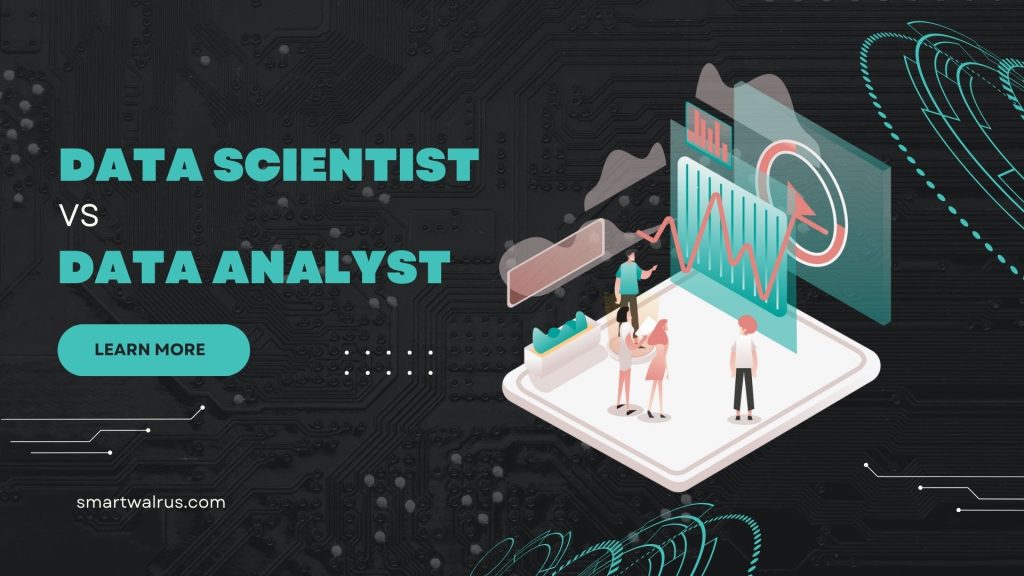What’s the Difference Between a Data Analyst and a Data Scientist?

Data analysts and data scientists have a lot in common. Both roles are critical to the success of your business. As such, it can be challenging to tell them apart at first glance.
This article will help you differentiate both roles in terms of responsibilities and also highlight their key differences. Read on to know more about what each role entails, as well as how you can use these insights effectively for your business agenda.
Table Comparison: Data Analyst and a Data Scientist
The table below compares the roles of a data analyst and a data scientist including aspects such as skillsets, tools, responsibilities, and more.
| Aspect | Data Analyst | Data Scientist |
|---|---|---|
| Focus | Analyzing data to provide insights and support business decisions. | Extracting insights, building models, and solving complex data problems. |
| Responsibilities | Cleansing and preprocessing data, creating reports and dashboards. | Strong in statistics, machine learning, data manipulation, and programming. |
| Skillset | Excel, SQL, and data visualization tools (e.g., Tableau, Power BI). | Proficient in SQL, data cleaning, visualization, and basic statistics. |
| Tools | Python/R, Jupyter, advanced analytics tools (e.g., TensorFlow, sci-kit-learn). | Deals with structured data, and simpler analysis tasks. |
| Business Impact | Supports business decisions with actionable insights from data. | Drives strategic decisions and innovation through data-driven methods. |
| Focus Area | This can lead to roles like Senior Data Analyst or Analytics Manager. | Focuses on predictive modeling, advanced analytics, and solving complex problems. |
| Problem Complexity | Handles unstructured and structured data, and more complex analysis tasks. | Often shorter projects, focus on specific questions or tasks. |
| Decision Support | Provides insights to inform tactical decisions and business operations. | Supports strategic decisions and innovation with data-driven insights. |
| Data Volume | Typically handles smaller to moderate-sized datasets. | Works with larger datasets, including big data scenarios. |
| Project Duration | Often shorter projects with focus on specific questions or tasks. | Can involve longer and more comprehensive projects, including research. |
| Machine Learning | Limited use of machine learning, if at all. | Extensively uses machine learning for predictive modeling and insights. |
| Job Titles | Data Analyst, Business Analyst, Reporting Analyst. | Data Scientist, Machine Learning Engineer, AI Specialist. |
| Academic Background | Often in business, economics, statistics, or related fields. | Often in computer science, statistics, engineering, or related fields. |
| Career Progression | Data preprocessing, predictive modeling, machine learning, and research. | It can lead to roles like Senior Data Scientist, Lead Data Scientist, or AI Researcher. |
Differences between roles and responsibilities
Both data scientists and data analysts work with data, but there are significant differences in their roles and responsibilities:
What is a Data Analyst?
A data analyst is responsible for analyzing data to get insight into what is happening in the business. They are responsible for the collection and transformation of data for analysis. Data analysts can be responsible for extracting information from various sources, mapping data, and integrating data.
They are a type of data science specialization and are key players in helping an organization gain insights from data. If you are interested in seeing the data from a specific source but do not know how to extract the data, or if you are looking to see the patterns from data, a data analyst is an ideal person.
Data analysts are also responsible for data quality assessment and correction. They can also be responsible for data governance. It is important to be able to evaluate the data so that you can make sure that it is accurate and complete. If you are not able to do that, you might end up drawing faulty conclusions from the data that could negatively affect your business decisions.
What is a Data Scientist?
A data scientist’s job is to understand the business problems first and then extract insights from the data. They can be responsible for performing the actual analysis. Data scientists are the ones who will create models, perform data analysis, and then produce insights for business decision-making. They will also design experiments to see how different variables affect different outcomes.
While analysts are responsible for analyzing data, data scientists are responsible for understanding the business and finding insights into the data. They may also be responsible for data engineering. They use statistics to understand the data and interpret it.
To perform such tasks, a data scientist uses programming languages, data science tools, and statistics. Overall, data scientists are responsible for the business impact of their findings, so they must be data-driven and understand the data context. Whereas data analytics managers provide direction for data analysts.
Responsibilities of a Data Analyst
Responsibilities of a Data Scientist
Summing up
There are many similarities between these two roles, but there are also key differences that set them apart. While both roles involve working with data, the responsibilities and skills required in each role are different.
Data scientists are primarily responsible for developing new models and future predictions, whereas data analysts are more focused on transforming data and managing data.

Related Data Analysis
The Statistics Skills Every Data Scientist Needs to Master
The Skills You Need To Master Data Science
How To Become A Data Analytics Manager
5 Steps To Developing A Health Informatics Career
What’s the Difference Between a Data Analyst and a Data Scientist?
7 Reasons Why You Should Become a Data Scientist
A Primer on Data Science in Government: From Projects to Problems
A Day in the Life of a Data Scientist: The Daily Routine